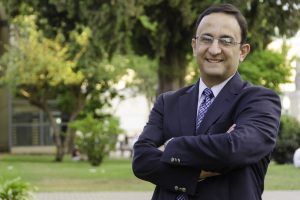
Gonzalo Pita is an associate research scientist, director of the Master’s in Systems Engineering program for Johns Hopkins Whiting School of Engineering’s (WSE’s) Department of Civil and Systems Engineering (CaSE), and an instructor for the school’s Engineering for Professionals’ (EP) program in environmental health and engineering and civil engineering. With his research centering on risk modeling of climate and earthquake hazards, systems analysis, and government policy design, Pita teaches classes in Natural Disaster Risk Modeling and System Dynamics and serves as a consultant to the World Bank in Washington, D.C.
What problems are you tackling through your research and why did you choose them?
My work is focused on risk science and policy, which involves assessing natural disaster risk on countries’ infrastructure systems and populations and developing control interventions.
I entered the field of natural disaster risk gradually. My first training was in structural and earthquake engineering. For my PhD, I researched granular problems on hurricane-induced structural damage mechanisms as part of the Florida Public Hurricane Loss Model. In my postdoctoral work, I addressed broader risk policy aspects. Finally, my involvement with the World Bank in D.C. brought new research and application opportunities on a nationwide scale for interrelated risk problems and this gave me a bird’s-eye view of the whole risk picture. What motivated me to move towards this field is that it’s highly multidisciplinary and systems-based, and there’s the opportunity to hopefully serve society through the reduction of disaster damages and protection of human life.
Does your current research seek to answer a fundamental question in science and engineering, or does it have potential practical ramifications? Tell us more about that.
It’s a bit of both. I tackle research questions about the potential risk ramifications in space and time both at the granular level of infrastructure to the broader aspects of government, disaster risk financing, and the (un)intended effects of public policy interventions.
The practical impacts include, among others, supporting the assessment and management of natural risks that threaten life, compromise buildings and infrastructure, and disrupt services; and affecting financial security by means of adequate policies. This involves the design of risk reduction and disaster risk financing instruments coverage.
For assessment and management of natural risks, there are three basic components. First, there’s the quantitative risk assessment operation. Next, disasters are characterized, which includes assessing impacts on the population and on revenues which might destabilize the public budget.
The third component is evaluating potential interventions and prioritization plans in search of the most effective solutions, but this isn’t as straightforward as it sounds, because the problem isn’t stationary. For example, while you design a strategy another hurricane may hit. The design of solutions is further complicated by the fact that risk is multidimensional—it affects the national systems at different levels, and so, usually this means deploying diverse instruments that jointly counteract the economic, fiscal, and human impacts.
How are your assessments impacting countries and government organizations?
I study and build components for catastrophe models; these are tools to model hurricane and earthquake damages and their uncertainty and disaster risk. These profiles help quantify the contingent liability of specific countries, in other words, their potential fiscal obligations arising from the occurrence of a future hurricane or other natural phenomena.
I work collaboratively in the development and deployment of risk-based asset information management systems for countries in the Caribbean and Southeast Asia. The outputs from these systems help ministries of public works to plan maintenance and repair activities; emergency management departments to complete damage assessments and repairs; and ministries of finance to quantify contingent liabilities and plan for disaster risk financing.
I also conduct research that helps support applied activities down the road, like modeling of inventory conditions, assessment of geographic patterns, such as floods, or crop types, using satellite radar imaging with machine learning techniques, and developing vulnerability functions, which are used to calculate the expected loss for seismic events.
These fascinating projects involve collaborations with other researchers and government officials from around the world, and graduate students from CaSE’s Master’s in Systems Engineering have gained valuable experience through participation in these projects.
What effect will your research have on nations and on the World Bank in the future?
A lot of brilliant and talented people who are working and have worked on these problems have made vast contributions to the reduction of suffering. I hope that my research at least makes some small positive impact on the welfare of people periodically affected by disasters. Hopefully, it will generate some useful tools and bring some clarity on interconnected risk problems from a “system of systems” approach.
What advice would you give to other professionals looking to apply their expertise in systems engineering to address global challenges, like natural disasters and climate change?
I believe that more people with a systems background are needed in the field. Some advice, for what it’s worth: it helps to be aware that certain approaches that worked in a certain region or country would not necessarily work equally well in other places (or at different times) due to differences in resource availability and sociotechnical systems structure. Try to identify the hidden feedback loops and delays to prepare against unintended consequences. In risk problems, try not to forget who you’re working for: the families that will be affected by severe disasters and the men and women who lead the efforts to minimize the impacts. A humble mindset helps analysts because the problems are formidable. Be up to date with the technical literature and seek opportunities to listen and learn from government officials, colleagues, experts, non-experts, and common-sense people.